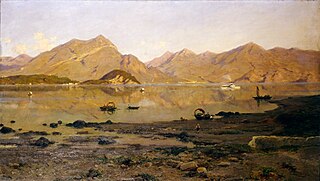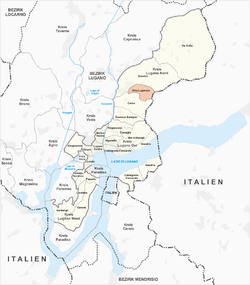
Lugano is a town and a municipality in southern Switzerland in the Italian-speaking canton of Ticino bordering Italy. It has a population of 63,185, and an urban agglomeration of over 150,000. The ninth largest Swiss town, it is the largest in Ticino and largest with an Italian speaking majority outside of Italy. The town lies on Lake Lugano, surrounded by the mountains of the Lugano Prealps.

Gandria is both a quarter of the city of Lugano in the Swiss canton of Ticino, and a village on the northern shore of Lake Lugano, which forms the core of that quarter. Until 2004, the quarter of Gandria was an independent municipality, joining with Lugano in that year.

There are 115 municipalities in the canton of Ticino, Switzerland,. Municipalities (comuni) are grouped in circles (circoli) which are part of districts (distretti).

Buenos Aires, autonomous city and capital of Argentina, is composed of forty-eight neighborhoods. Since 2008, the city is also legally divided into communes, each one including one or more barrios. Among the most visited and populated barrios are Palermo, Recoleta, Puerto Madero, Belgrano, San Telmo, La Boca, Monserrat and Caballito. Sectors of the city are also traditionally known as neighborhoods by the inhabitants of Buenos Aires, but not officially by the authorities of the city; some examples include Chinatown, Barrio Norte and the Microcentro.

Lugano was the name of a canton of the Helvetic Republic from 1798 to 1803, with its capital at Lugano. The canton unified the former Landvogteien of Lugano, Mendrisio, Locarno and Valmaggia.

Valsolda is a comune (municipality) of about 1,400 inhabitants in the Province of Como in the Italian region Lombardy on the border with Switzerland. It is located about 60 kilometres (37 mi) north of Milan, about 25 kilometres (16 mi) north of Como and 2 kilometres (1.2 mi) east of Lugano.
The Lugano District is a district of Canton of Ticino, southern Switzerland. The capital is the city of Lugano.

Barbengo is a quarter of the city of Lugano, Switzerland. It includes the settlements of Cadepiano, Campagnore, Casaccia, Cernesio, Garaverio and Figino. Barbengo was formerly a municipality of its own, having been incorporated into Lugano in 2008.

Bioggio is a municipality in the district of Lugano, in the canton of Ticino in Switzerland.

Villa Soldati is a neighbourhood in Buenos Aires, Argentina, located in the South-West of the city. It has a population of approximately 41,000 people, 40% of which live in Barrio Soldati, a public housing development built between 1973 and 1979.

Villa Lugano is a neighbourhood in Buenos Aires, Argentina, located in the south of the city. It has a population of approximately 114,000 people.

The Museum of Cultures is one of the museums that forms part of the Cultural Pole of the city of Lugano in Switzerland. Originally situated in the Heleneum, a villa on the shore of Lake Lugano to the east of the city centre, and in the quarter of Castagnola, since 2016 the Museum has been located to Villa Malpensata, a site closer to the center of Lugano.

Silvio Poma was an Italian painter, mainly painting land and lake-side seascapes of the Lombardy lake district.
Trasporti Pubblici Luganesi (TPL) is a public transport operator in and around the Swiss city of Lugano. Previously known as the Società luganese dei tramway elettrici, Tranvie elettriche comunali, Azienda comunale del traffico (ACT) and Azienda comunale dei trasporti della Città di Lugano (ACTL), the organisation was founded in 1884 and adopted its current name in 2000.

The Lugano tramway network was part of the public transport network of Lugano, in the canton of Ticino, Switzerland, for over half a century. Opened in 1896, the network was progressively replaced by the Lugano trolleybus system by 1959, with one independent line surviving until 1964.

Saint Lucius in Brugherio, Italy, is a small church dedicated to Saint Lucius in the grounds of the Villa Sormani. First located in Lugano, Switzerland, where it was a Franciscan chapel, the building was disassembled and transported to Brugherio where its reconstruction was completed 17 years later.
Gabino Ezeiza is a station on the Buenos Aires Premetro. The station is on the branch that terminates at General Savio station. It was opened on 29 April 1987 together with the other Premetro stations. The station is located between the Barrios of Villa Lugano and Villa Riachuelo, near the Autódromo Juan y Oscar Gálvez.

General Savio is a station on the Buenos Aires Premetro. The station is on the branch that terminates at General Savio station. It was opened on 29 April 1987 together with the other Premetro stations. The station is located between the Barrios of Villa Lugano and Villa Riachuelo, near the Autódromo Juan y Oscar Gálvez. It is the terminal station on this branch of the Premetro.
Carlo Giuseppe Plura was a Swiss-Italian stucco artist and sculptor. He was born in Lugano and died in Borgo San Dalmazzo. Like him, his son Giuseppe Antonio Plura the Elder and Giuseppe Plura the Younger were both sculptors and both active in the United Kingdom.
Francesco Chiesa was an Italian-speaking Swiss poet and short story writer. He was awarded the Grand Prix Schiller Prize in 1928.
















